市场资讯及洞察

Most traders understand EA portfolio balance through the lens of traditional risk management — controlling position sizes, diversifying currency pairs, or limiting exposure per trade.
But in automated trading, balance is about deliberately constructing a portfolio where different strategies complement each other, measuring their collective performance, and actively managing the mix based on those measurements.
The goal is to create a “book” of EAs that can help diversify performance over time, even when individual strategies hit rough patches.
A diversified mix of EAs across timeframes and assets can, in some cases, reduce reliance on any single strategy. This approach reduces dependency on any single EA’s performance, smooths your overall equity curve, and builds resilience across changing market conditions.
It’s about running the right mix, identifying gaps in your coverage, and viewing your automated trading operation as an integrated whole rather than a collection of independent systems.
Basic Evaluation Metrics – Your Start Point
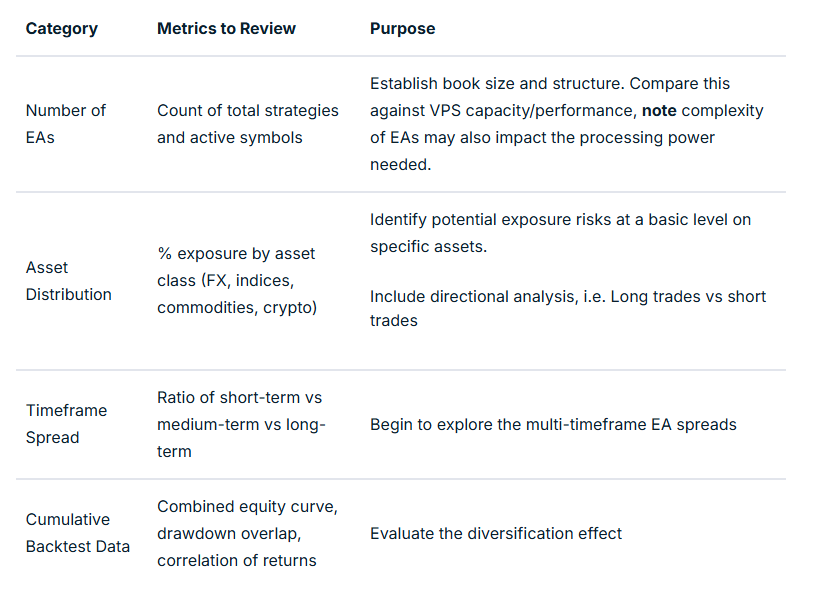
Temporal (timeframe) Balancing
When combined, a timeframe balance (even on the same model and instrument) can help flatten equity swings.
For example, a losing phase in a fast-acting M15 EA can often coincide with a profitable run in an H4 trend model.
Combining this with some market regime and sessional analysis can be beneficial.
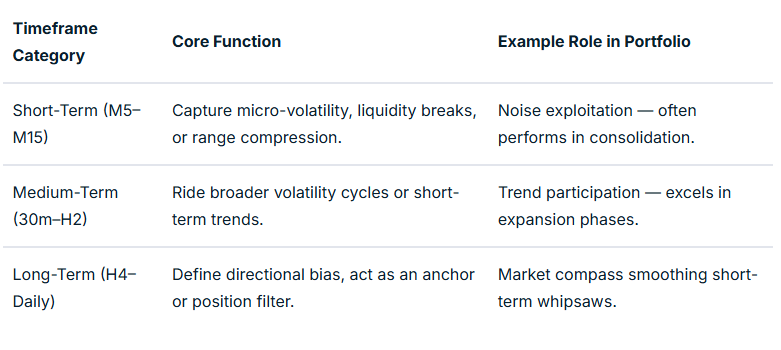
Asset Balance: Managing Systemic Correlation Risk
Running five different EAs on USDJPY might feel diversified if each uses different entry logic, even though they share the same systemic market driver.
But in an EA context, correlation measurement is not necessarily between prices, but between EA returns (equity changes) relating to specific strategies in specific market conditions.
Two EAs on the same symbol might use completely different logic and thus have near-zero correlation.
Conversely, two EAs on a different symbol may feel as though they should offer some balance, but if highly correlated in specific market conditions may not achieve your balancing aim.
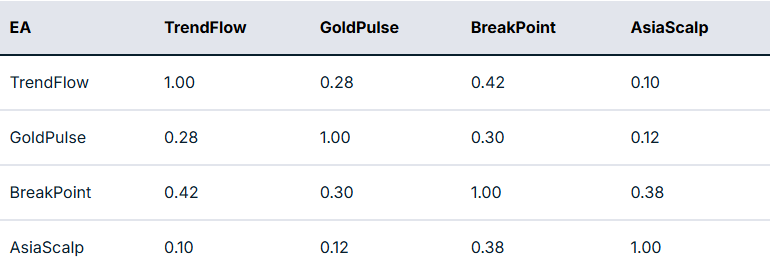
In practical terms, the next step is to take this measurement and map it to potential actionable interventions.
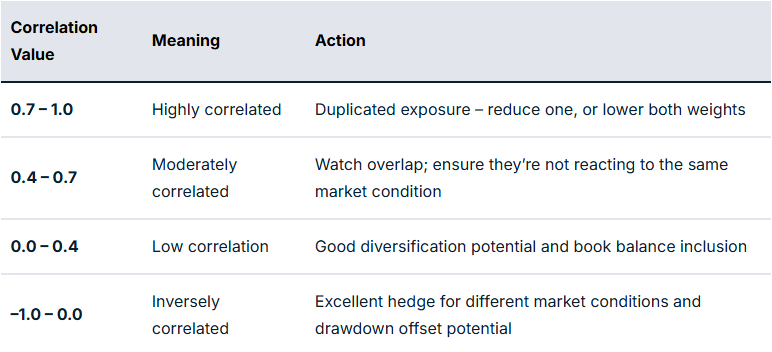
For example, if you have a EURUSD Trend EA and a GBPUSD Breakout EA with a correlation of 0.85, they are behaving like twins in performance related to specific market circumstances. And so you may want to limit exposure to some degree if you are finding that there are many relationships like this.
However, if your gold mean reversion EA correlates 0.25 compared to the rest of your book, this may offer some balance through reducing portfolio drawdown overlap.
Directional and Sentiment Balance
Markets are commonly described as risk-on or risk-off. This bias at any particular time is very likely to impact EA performance, dependent on how well balanced you are to deal with each scenario.
You may have heard the old market cliché of “up the staircase and down the elevator shaft” to describe how prices may move in alternative directions. It does appear that optimisation for each direction, rather than EAs that trade long and short, may offer better outcomes as two separate EAs rather than one catch-all.
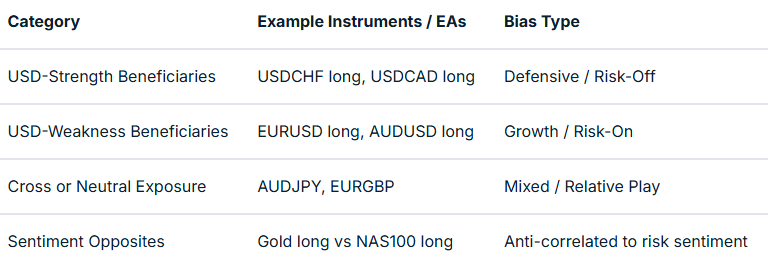
Market Regime and Volatility Balance
Trend and volatility states can have a profound impact on price action, whether as part of a discretionary or EA trading system. Much of this has a direct relationship to time of day, including the nature of individual sessions.
We have a market regime filter that incorporates trend and volatility factors in many EAs to account for this. This can be mapped and tested on a backtest and in a live environment to give evidence of strategy suitability for specific market conditions.
For example, mean reversion strategies may work well in the Asian session but less so in strongly trending markets and the higher volatility of the early part of the US session.
As part of balancing, you are asking questions as to whether you actually have EA strategies suited to different market regimes in place, or are you using these together to optimise book performance?
The table below summarises such an approach of regime vs market mapping:
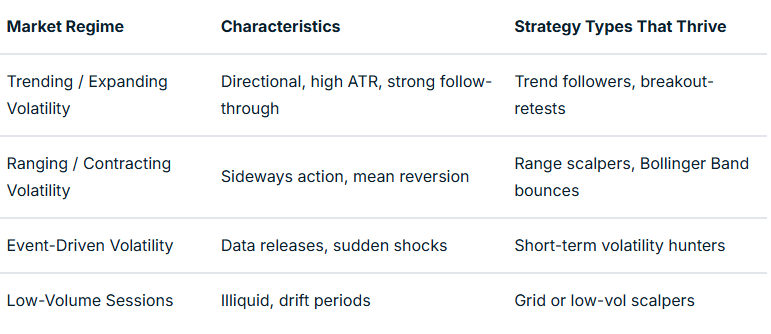
Multi-Level Analysis: From Composition to Interaction
Once your book is structured, the challenge is to turn it into something workable. An additional layer of refinement that turns theory and measurement into something meaningful in action is where any difference will be made.
This “closing the circle” is based on evidence and a true understanding of how your EAs are behaving together. It is the step that takes you to the point where automation can begin to move to the next level.
Mapping relationships with robust and detailed performance evaluation will take time to provide evidence that these are actually making a difference in meeting balancing aims.
To really excel, you should have systems in place that allow ongoing evaluation of the approaches you are using and advise of refinements that may improve things over time.
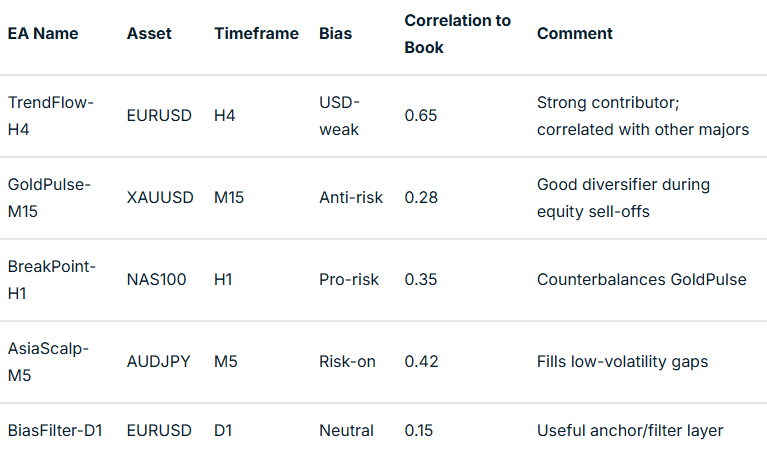
What Next? – Implementing Balance in Practice
Theory must ultimately translate into an executable EA book. A plan of action with landmarks to show progress and maintain motivation is crucial in this approach.
Defining classification tags, setting risk weights, and building monitoring dashboards are all worth consideration.
Advanced EA traders could also consider a supervisory ‘Sentinel’ EA, or ‘mothership’ approach, to enable or disable EAs dynamically based on underlying market metrics and external information integrated into EA coding decision-making.
Final Thoughts
A balanced EA portfolio is not generated by accident; it is well-thought-out, evidence-based and a continuously developing architecture. It is designed to offer improved risk management across your EA portfolio and improved trading outcomes.
Your process begins with mapping your existing strategies by number, asset, and timeframe, then expands into analysing correlations, directional bias, and volatility regimes.
When you reach the stage where one EA’s drawdown is another’s opportunity, you are no longer simply trading models but managing a system of EA systems. To finish, ask yourself the question, “Could this approach contribute to improved outcomes over time?”. If your answer is “yes,” then your mission is clear.
If you are interested in learning more about adding EAs to your trading toolbox, join the new GO EA Programme (coming soon) by contacting [email protected].
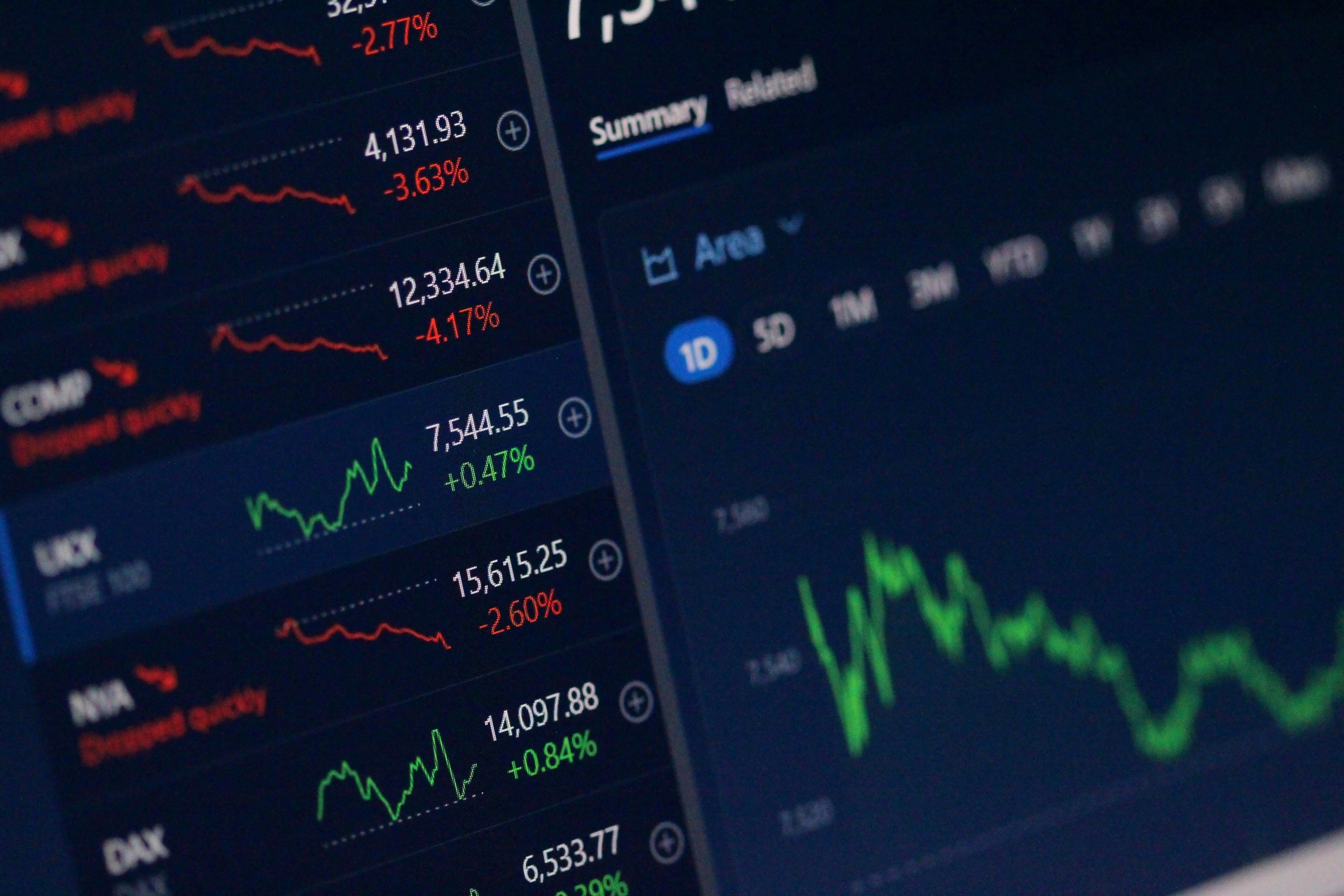

上周市场在多项重磅经济数据密集发布后迅速波动,而本周虽暂未有关键经济指标公布,却已有多项消息酝酿重大影响。联储内部动向、全球关税政策进展与非农修正事件,成为当前市场焦点。 1. 关税政策落地,多国进口税上调美方贸易办公室已确认此前宣布的多国加税措施将进入正式执行阶段,对多国商品加征25%至50%不等的进口税,涉及多个主要贸易伙伴。相关表态中强调,此轮加税是基于双边贸易差额而定,当前不会重新调整税率。这一决定标志着全球贸易政策可能进入新一轮博弈期。 2. 非农数据遭修正,引发信任危机美方6月与5月非农数据被大幅下修,共计减少近30万人,令市场震惊。尽管7月数据仍呈现正值,但对就业市场的乐观预期已被明显削弱。受事件影响,劳工管理高层被更替,联储系统内也出现人事调整。其中一位具代表性的理事官员在此期间提出辞职,其曾被视为偏中性的联储成员。市场解读为未来决策层面将可能向更支持货币宽松的方向调整,从而加大年内降息的可能性。 3. 本周数据真空,股市或进入盘整期美股本周面临“财报收尾+数据真空”的组合局面,若无更多积极推动因素,短线或维持区间震荡。目前市场预期三季度将可能出现季节性调整,尤其在前期涨幅已较明显的背景下,情绪面偏谨慎。 4. 金融市场波动加剧,黄金与美元走出反向走势就业数据修正影响美元信心,美元指数跌破99,黄金价格则大幅上扬,触及每盎司3350美元,为阶段高位。油价短线震荡,比特币仍呈现弱势整理格局。汇市方面,非美货币普遍走强,美元兑人民币一度跌至7.19下方,澳元兑美元守稳0.64,兑人民币小幅调整。免责声明:GO Markets 分析师或外部发言人提供的信息基于其独立分析或个人经验。所表达的观点或交易风格仅代表其个人;并不代表 GO Markets 的观点或立场。联系方式:墨尔本 03 8658 0603悉尼 02 9188 0418中国地区(中文) 400 120 8537中国地区(英文) +248 4 671 903作者:Xavier Zhang | GO Markets 高级分析师


Many traders begin their exploration of indicators with the assumption that “more tools” equals “more clarity.” The result is stacking indicator after indicator into the chart in the hope that it will reveal the perfect moment for entry when everything aligns.But rather than offering clarity, it often results in conflict with some indicators suggesting “buy,” while another says “wait.”
What Are Indicators and What Are They Not?
Indicators are tools, not predictors.They don’t forecast the future, they analyse past price movement and associated variables and relationships using mathematical formulas. They cannot tell you with certainty what will happen next, eliminate risk, prevent losses, or work consistently in every market condition with every asset type.However, this does not mean they are not useful. Previous price action does have an influence on current price movement. What indicators can help with is quantifying market behaviour up to a point in time. They provide context for current price action and have a strong role in defining potential risk parameters like stops or targets.Price action should always be king for both entry and exit trading decisions. But some confluence (the level of agreement or refuting what you see in price) relating to the overall context can also be key to system development and implementation.Additionally, strong, specific, and unambiguous objective criteria can offer some clarity and consistency in action, which is crucial for performance evaluation.
What Are You Actually Measuring?
You should never use an indicator as part of your decisions unless you know what it is telling you about the market. Indicators are at their most powerful when combined with current price action and market structure (e.g., key levels).Most indicators fall into one of four core types:
1. Trend-Following Indicators
Examples: Moving Averages (MA), MACD, ADXWhat they do: Smooth price to identify direction and filter out potential market noiseHow they help: Keep you trading in the dominant direction. e.g., by checking trends on longer timeframes or through comparison of different period MA’s can give confirmation that trend may be nearing its end, changing, or has changed already.
2. Momentum Indicators
Examples: RSI, Stochastic, What they do: Measure the speed and strength of price movesHow they help: Can help spot overbought/oversold areas that mean the market may be more likely to change. Some also utilize them to look for divergence in direction versus price as a suggestion that things may be about to change.
3. Volatility Indicators
Examples: ATR, Bollinger Bands,What they do: Measure how far the price is moving within a specified chart time windowHow they help: Stop loss and take profit level placement. e.g., a multiple of current ATR may help anticipate breakouts and can be used in some mean reversion strategies on a price reversal or bounce.
4. Volume-Based Indicators
Examples: Volume Profile, Average, and relative volumeWhat they do: Indicate buying and selling activity behind price moves.How they help: Show commitment behind a move and may indicate the strength of a move or deviation from the norm.Where they fail: Limited usefulness in markets with unreliable volume data (e.g., spot FX)
Common Indicator Errors
1. Stacking Indicators That Do the Same Thing
This is probably the most common mistake people make with indicators.For example, using RSI and Stochastic at the same time —they're both momentum indicators. This leads to confirmation bias, not confidence.
2. Only Trading When Everything Aligns
Waiting for all your indicators to “line up” may delay good trades. This should not take away from having clear criteria articulated in your trading plan, but if you have a system that is too complex, you will find it becomes too hard to implement, and you end up ignoring your criteria anyway.
3. Attempting to Use Indicators to Fix a Poor System
“If I just add this one more indicator filter, I can avoid bad trades.”This is rarely the case. The primary reasons traders run into problems are that their system is poorly defined or there are problems following it. Adding yet another indicator to the many you may already have is unlikely to make any difference. This mindset leads to paralysis. Risk is part of trading — indicators refine edge, not remove risk.
4. Following Signals Without Price Action or Market Context
Blindly buying on MACD crossover or RSI below 30 not only ignores actual price but also other key factors such as market structure, news, sentiment, or time of day, all of which can have a massive impact on what happens next.
Purposeful Use of Indicators
The most effective traders simplify. They use fewer indicators but aim to use them in a better way. Here is some practical guidance that is worth considering:Use One or Two Indicators Per Function:
- One trend filter (e.g., 50 EMA)
- One volatility tool (e.g,. ATR for stops)
- One timing/momentum indicator (e.g., RSI)
This will help keep your chart clean, your strategy simpler, and your decision-making fast.Make Each Indicator Answer a Specific Question:Before you add any decision-making tool to your chart, consider what question you are trying to answer about your trading idea and which indicator serves this best.Use Indicators to Support Structure — Not Replace It:Remember that it is price that tells the story. Indicators provide extra evidence to support any price-based decision.
Indicator Audit Checklist
This 6-question checklist can help you decide whether to keep, remove, or replace an indicator on your chart.QuestionYesNoDoes this indicator provide information I don’t get elsewhere?Worth keepingLikely redundantDo I understand how it is calculated and what it is measuring?Use it with confidenceLearn it or remove itDoes it align with my trading style?RelevantMisalignedDoes it help me make faster/more confident decisions?Value-addingCluttering judgmentIs it part of a clearly defined process?PurposefulArbitraryHave I backtested or forward-tested it within my system?ProvenDangerous guesswork
Final Thoughts
Indicators are not the enemy of the trader, but it is clear that the indiscriminate use of them may be ill-advised.Consider carefully what you are going to put on your chart, making sure that you strive for clarity in your trading system processes first, and then indicators can prove to be invaluable.


Despite all of the enthusiasm, energy, and airplay entries receive, it is your exit that determines if your trade is considered successful or not.Yet most traders, even those with experience, continue to obsess over how to get into a trade, often treating the exit as an afterthought in comparison. They can recite their setup criteria at the drop of a hat, providing great step-by-step (and often complex) details. But when asked, “How do you decide when to get out?” that clarity and thoroughness are noticeably absent or vague. No matter what type of trader you are, it is your exit strategy that shapes your risk-reward, determines your win rate, and ultimately defines your trading edge.
Why Most Traders Struggle With Exits
Exiting trades effectively is more difficult than entering.Not only are you trying to read what is currently happening, but there is a level of prediction needed to decide what may happen next.Let’s start with the three most common exit challenges that traders face:
1. Emotional Exits
Many traders close positions prematurely. Not because their setup failed or their exit plan is unclear, but simply because they feel increasingly uncomfortable. This usually stems from fear of giving back existing profit or getting sucked in emotionally to every price move and market noise.This inconsistency in action makes it difficult to determine if your trading strategy is effective. You constantly adjust actions that deviate from your planned strategy, rather than having evidence of performance and how to refine it.
2. Fixed Exits That Don’t Fit the Market
Some traders apply the same x pips/points risk-reward target for every trade, regardless of volatility, current market structure, instrument pricing, direction, or timeframe. While mechanical consistency has its place, ignoring market context can lead to premature exits in trending conditions, overstretched targets in low-volatility environments, and stops too tight to withstand normal price noise.Your exit approaches need to be dynamic to reflect market behaviour. A 20-pip exit might be fine for a 30-minute chart, but it is completely inappropriate for a 4-hourly trade. Consider using variables that adjust with the underlying asset, timeframe, and volatility. E.g., an ATR multiple rather than set points or pips.
3. Poor Exit Plan on Entry
The number one cardinal sin is to have an absent or poorly defined exit plan. When your exits are not effectively pre-planned, decisions are always reactive. As you watch the screen, waiting to "see what happens," you are more likely to:
- Hesitate when you should not
- Regret when you see what you should have done and did not
- Miss regular opportunities for profit
- Sustain larger losses than you should have
You can have the most amazing entry approaches in the world, but if you haven’t made the strategic decision on when and how to exit, your trading outcomes will fall short of expectations.
Reframing Your Exit
To improve your exits, you need to treat them as a strategic component of your system, not a secondary detail. A good exit plan is always:
- Intentional – You know why you’re exiting, consistent with your overall trading objective and financial situation
- Structured – You know how you’re going to exit before you place the trade.
- Adaptive – Your criteria and approaches can adjust to the type of trade or market conditions.
- Consistent – You execute your exit criteria with discipline and consistency, not emotionally driven impulse.
Types of Exit Strategies
Profit Target and Stop-Loss Structure
Even if you are using price action (or another exit approach) for stop loss placement, you should still consider a “safety net” stop to manage a possible catastrophic candle or gap.Ideally, these should be based on something that responds to instrument and timeframe idiosyncrasies.
Signal-Based Exits
This falls into the profit risk category. With signal-based exits, we are looking for a situation where a technical reversal happened before a trail stop being triggered.An example of this could be that you see a technical double top forming as a reversal signal on a long trade (or double bottom on a short trade).
Partial Closes
Although this is not a full exit approach, it is good for the management of profit risk. There are two scenarios where this may be considered:
- The price has moved a predetermined level towards your ultimate profit.
- As an alternative to full exit — it can limit risk while retaining some interest in the trade and locking in profit before a predictable market-moving event.
Moving Forward with Exits
Exit strategy is a process of evaluating where you are now and then putting in the work to fill in any gaps.Here’s a simple six-point audit checklist tool you can use to review your trade exits:QuestionYesNoWas my exit plan defined before I entered the trade?☐☐Did I follow my exit logic without emotional interference?☐☐Was the exit based on price structure, volatility, or a technical signal?☐☐Did my exit strategy align with the type of trade?☐☐Was I satisfied with the efficiency of the exit (profit vs. potential)?☐☐Would I exit the same way again if the trade repeated?☐☐
Final Thoughts
You have equal control of exits as you have over entries. It is your responsibility to exercise that control if you are serious about moving forward with your trading.Professional traders define where to get out before they get in. They accept that some trades will reverse, others will trail out, but the aim should be long-term consistency in action.The exit is the point at which you either receive your market “pay-check” or effectively manage capital risk so you are ready for the next opportunity. It is worth the equal effort and commitment that you give to your trade entries.


今天我们不聊马斯克、不讲苹果,而是请出一位你可能没听说过,但每天都在用的“幕后英雄”——Figma!就在昨晚,他上市了!开盘当天股价重现了Circle的风光时刻,IPO定价为33美元,开盘价85美元,最终收于116.30美元,盘后一度涨到146美元。这哥们是谁?一句话概括:“网页上的设计神器,程序员和设计师的共同战壕。”你每天打开的App、网页,那些漂漂亮亮的界面、圆润的按钮、会动的动画,很可能就是某位设计师在Figma里点点点、拉拉拉、拖拖拖搞出来的。谁是Figma?Figma最大的看家本领就是:“设计不求人,远程协作一点就行。”传统设计工具,比如Adobe家的Photoshop、Illustrator,功能确实强大,但对新手极其不友好,一个界面能把设计小白劝退三轮;你想协作?只能发PSD传来传去,一边画图一边骂“谁又动了我的图层?!”Figma出来之后直接开大招:“兄弟姐妹们,来吧,一起在网页上画图,就像用谷歌文档一样!”于是设计师喜极而泣,打工人鼓掌叫好,老板也眼含热泪:“终于不用买高配电脑跑设计软件了!”疫情期间大家都居家办公,Figma这波“协作+云端+居家办公”三重Buff直接拉满,用户数飙升,成了设计圈的“顶流”。Adobe看上了它,结果——黄了!时间来到2022年,Figma实在太火,老牌设计巨头Adobe坐不住了:“这小子抢我XD和UI用户,我不收了它,还怎么维持我创意软件一哥的地位?”于是Adobe大手一挥,报价200亿美元现金+股票收购Figma,创下历史最大软件工具并购之一。Figma也收拾行李,准备入住Adobe的“大豪斯”。结果还没过门,“叮咚——反垄断警察来了!”欧美监管机构一拍桌子:“你Adobe都快垄断设计界了,还想把唯一的‘后起之秀’也收走?没门!”最后这桩世纪联姻胎死腹中,双方于2023年底官宣分手。表面上是监管反对,但业内八卦却认为,Adobe根本就没怎么认真争取,而是——变心了。AI来了,Figma哭了,Adobe也不爱了2022年底,ChatGPT发布,AI一夜之间站在了风口浪尖,Adobe当即悟了:“未来的设计,还画啥图?一段提示词搞定一切!”于是Adobe转身投入AI怀抱,Figma突然成了“过去式的投资”。收购的兴趣也冷了,像极了电视剧里那种“我妈不同意我们在一起”的分手场景。Figma很懵:“哈?你不是说好娶我的吗?”不过Figma也不是吃素的,立马反手来一句:“那我就自己上,IPO见!”财务成绩单:小透明也能硬刚巨头别看Figma被退了婚,它的财务成绩单相当能打:2024年营收达8.21亿美元,同比增长48%,自由现金流利润率高达28%(同行中位数才18%),全球用户超1300万,80%以上来自美国以外。这水平,已经是“赚钱界的清流”“设计界的尖子生”。所以说,不上市都对不起自己这成绩。AI是救星还是滑铁卢?当然,Figma也知道不能只靠旧模式吃老本,也要AI化,于是推出了Figma Make:“你说一句话,它就能生成一整个App原型,自动带交互。”听着很猛,结果刚上线就被网友吐槽:“你这不就是Vision Pro演示的翻版?”最后不得不下架整改,打脸啪啪响。与此同时,Framer、Cursor、Llama、Lilin、Penpot等一众AI设计工具早已杀疯,纷纷推出“自动排版”“智能设计助手”。甚至连完全不会设计的人,现在都能用AI拖个网站、拼个原型,三分钟出成品。有设计师表示:“我直接截图Figma里的草稿丢给Cursor,AI给我出高保真页面,比手动快十倍。”Figma有点慌,但还得装镇定。一边砸钱搞AI研发,一边祈祷用户别被别家AI工具挖走。那Figma会不会凉?说实话,现在的Figma就像一个聪明又努力的实习生,能干些活,也挺懂事,但离成为“AI时代的设计副驾”还有点距离。目前Figma的AI功能更多是试验性质,还达不到像微软Copilot那种全流程辅助的水平。而竞品在猛追、AI迭代飞快,能不能守住自己的C位,全看它能不能尽快把AI这张牌打明白。但有一点可以肯定——在这个人人都讲AI故事的时代,Figma至少在讲真话、干实事,不像一堆光说不练的“泡沫独角兽”。免责声明:GO Markets 分析师或外部发言人提供的信息基于其独立分析或个人经验。所表达的观点或交易风格仅代表其个人;并不代表 GO Markets 的观点或立场。联系方式:墨尔本 03 8658 0603悉尼 02 9188 0418中国地区(中文) 400 120 8537中国地区(英文) +248 4 671 903作者:Mill Li | GO Markets 墨尔本中文部


刚刚过去的24小时,对市场而言堪称“信息风暴”——经济数据、政策表态、企业财报与地缘消息接连释放,金融市场步入真正意义上的多线博弈阶段。首先是硬数据重磅落地。美国第二季度GDP年化增速达到3%,远超预期的2.4%,不仅显著反转前值-0.5%的表现,也彻底打消了市场对经济衰退的担忧。同时,二季度核心PCE年化增速回落至2.5%,显示通胀有所缓解的趋势。但需注意,通胀仍未明确转折,今晚即将公布的6月核心PCE(预期2.7%)将进一步验证通胀压力是否真正在消退。就业方面,非官方“小非农”数据显著高于预期,为周五非农数据“预热”。鲍威尔在美联储会议后重申,当前通胀控制优先于就业担忧,联储内部对于利率路径出现明显分歧,已有两位票委投下反对票,为30年来首次。尽管维持利率不变,鲍威尔未明确给出降息时间表,甚至在新闻发布会上“偏鹰”,导致美股后半段显著回吐涨幅。不过,高科技巨头撑起了市场信心。微软与Meta发布强劲财报后股价盘后大涨,提振整体股指期货上涨,今晚市场情绪有望延续向好。与此同时,苹果与亚马逊财报将在明晨公布,市场普遍持乐观预期。美元方面,受数据连续利好推动,强势上涨逼近100大关。此前我们提及的澳美、美日等美系货币对已出现波段性机会,黄金受压回落,人民币汇率受美元带动被动调整,澳元兑人民币顺势回落,整体逻辑均被验证。政策方面,白宫如期发布数字资产监管报告,未透露比特币储备计划的新增内容,数字货币板块整体波动有限;关税消息再起波澜,特朗普宣布对印度加征25%关税、对巴西加征50%关税,欧美协议遭法国公开批评,后续谈判空间仍存。市场正在迎来七月收官与八月布局的关键窗口期,建议投资者关注今晚核心PCE及重磅财报发布,同时留意美元强势周期下的交叉资产波动,合理配置仓位与节奏,控制情绪性交易风险。联系方式:墨尔本 03 8658 0603悉尼 02 9188 0418中国地区(中文) 400 120 8537中国地区(英文) +248 4 671 903作者:Xavier Zhang | GO Markets 高级分析师


在这个信息爆炸的时代,炒股早已不是拍脑袋做决定的年代。面对成千上万只股票,如何从中筛选出真正有潜力的标的,成了每个投资者绕不过去的问题。靠消息?靠感觉?这些方法或许偶尔奏效,但注定难以长期稳定。这时候,一个强大的工具——TradingView,能帮你大大提升效率。作为全球领先的图表分析平台,TradingView不仅有丰富的技术指标和图形工具,更内置了强大的股票筛选器(Stock Screener),帮助你用数据说话、用逻辑选股。本文将带你一步步了解如何在TradingView上进行科学的选股操作,让你从海量股票中,快速定位符合你策略的优质标的。目前GO Markets已正式支持TradingView交易功能,连接账户后即可直接在图表上下单,省时又高效。还没体验过?快来注册一个试试吧!首先,打开我们的Tradingview筛选器平台:https://cn.tradingview.com/screener/
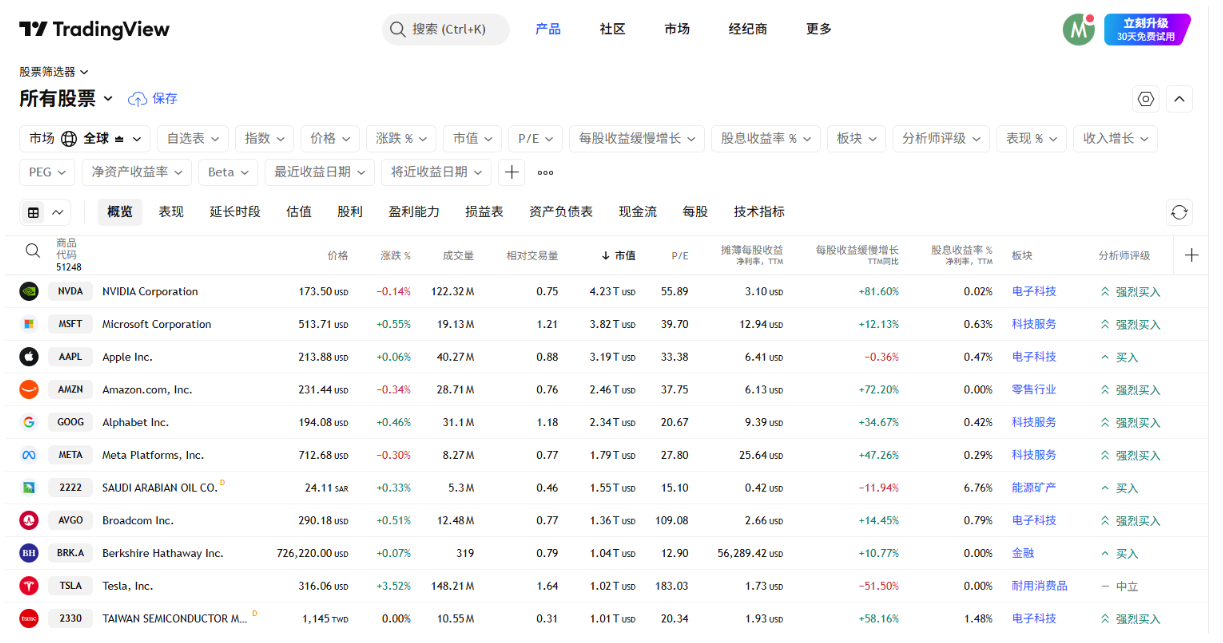
在页面上方的筛选选项中,我们可以根据一系列技术指标和基本面指标来筛选股票,也可以按地区进行分类。例如,如果我们想筛选出所有美国市场中、过去一天涨幅超过5%的大盘股,只需在筛选器中分别设置“市场”为“美国”、“涨跌幅”大于5%、“市值”选择“大盘股”,即可快速获得符合条件的股票列表。
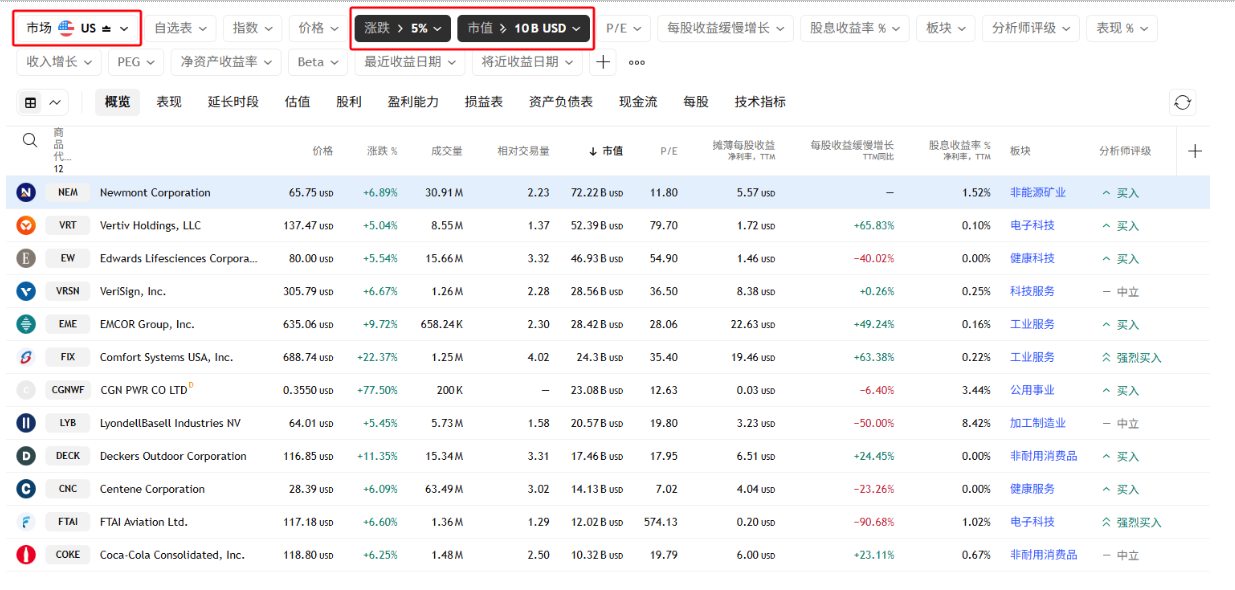
我们也可以设置更复杂的筛选条件,例如:如果我们希望找出近期在底部放量,且放量前处于下降趋势的个股,该如何操作?首先,可以设定两个基础条件,来判断股票是否处于下跌通道中:-股价小于等于50日简单移动平均线(SMA50),说明当前价格仍位于中期均线之下;-年初至今收益率为负,进一步确认这只股票今年整体处于下行趋势。
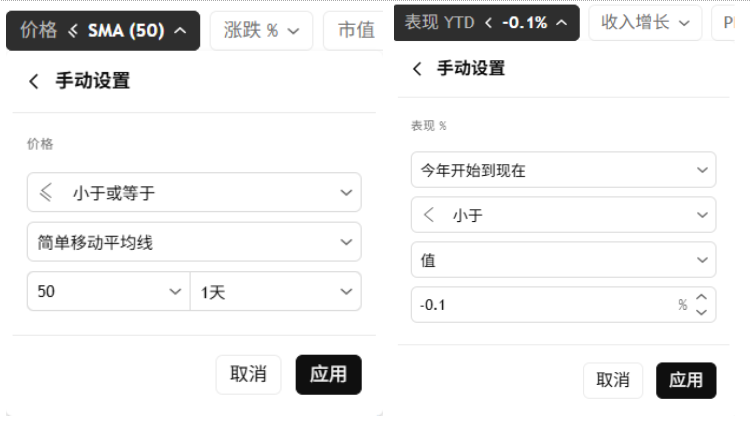
接下来,我们可以通过点击筛选器中的“+”号,添加成交量相关的条件。具体做法是:设定最近一天的成交量要高于过去30天平均成交量的100%,也就是至少放大一倍。通过这个条件,我们可以筛选出近期出现明显放量的个股。
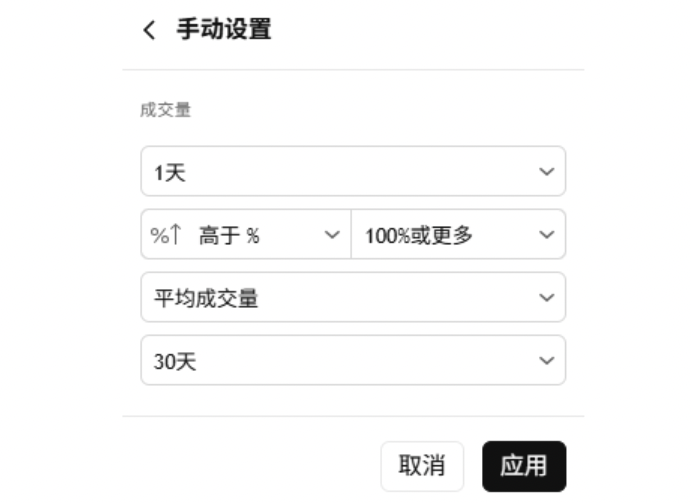
综合以上三个筛选条件:1. 股价低于或等于50日均线,2. 年初至今收益为负,3. 最近一天成交量大于30日均量的两倍,我们就能精准筛选出当前底部放量、此前处于下跌趋势的个股列表:
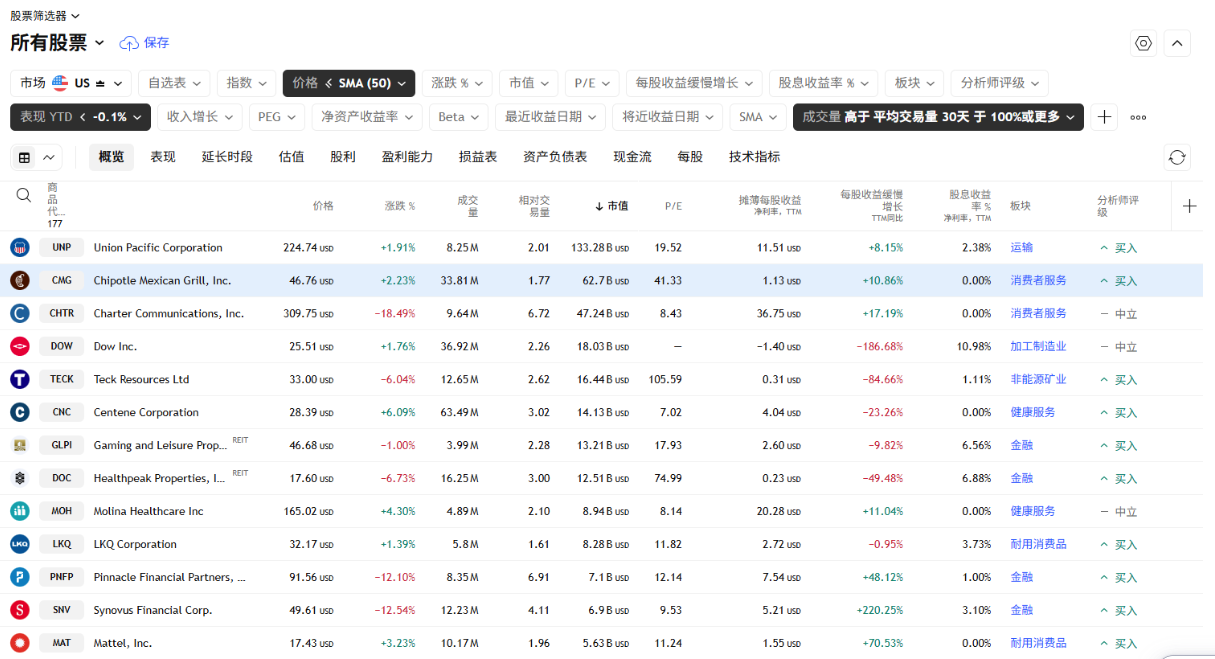
总的来说,这种基于条件组合的选股方法,简单高效,远比我们逐一手动查找个股来得省时省力。在如今这个信息密集、交易节奏加快的量化时代,掌握一套快速、科学的选股流程,已经成为投资者的必备技能。很多时候,快人一步入场,就可能获得更理想的收益;而犹豫迟疑,往往就与机会擦肩而过。TradingView提供的股票筛选器,不仅逻辑清晰、设置灵活,而且可以帮助我们在庞大的市场中迅速定位潜力个股。希望这篇文章能帮你开启TradingView筛股的第一步,让你的投资更高效、更有依据。免责声明:GO Markets 分析师或外部发言人提供的信息基于其独立分析或个人经验。所表达的观点或交易风格仅代表其个人;并不代表 GO Markets 的观点或立场。联系方式:墨尔本 03 8658 0603悉尼 02 9188 0418中国地区(中文) 400 120 8537中国地区(英文) +248 4 671 903作者:Michael Miao | GO Markets 悉尼中文部

